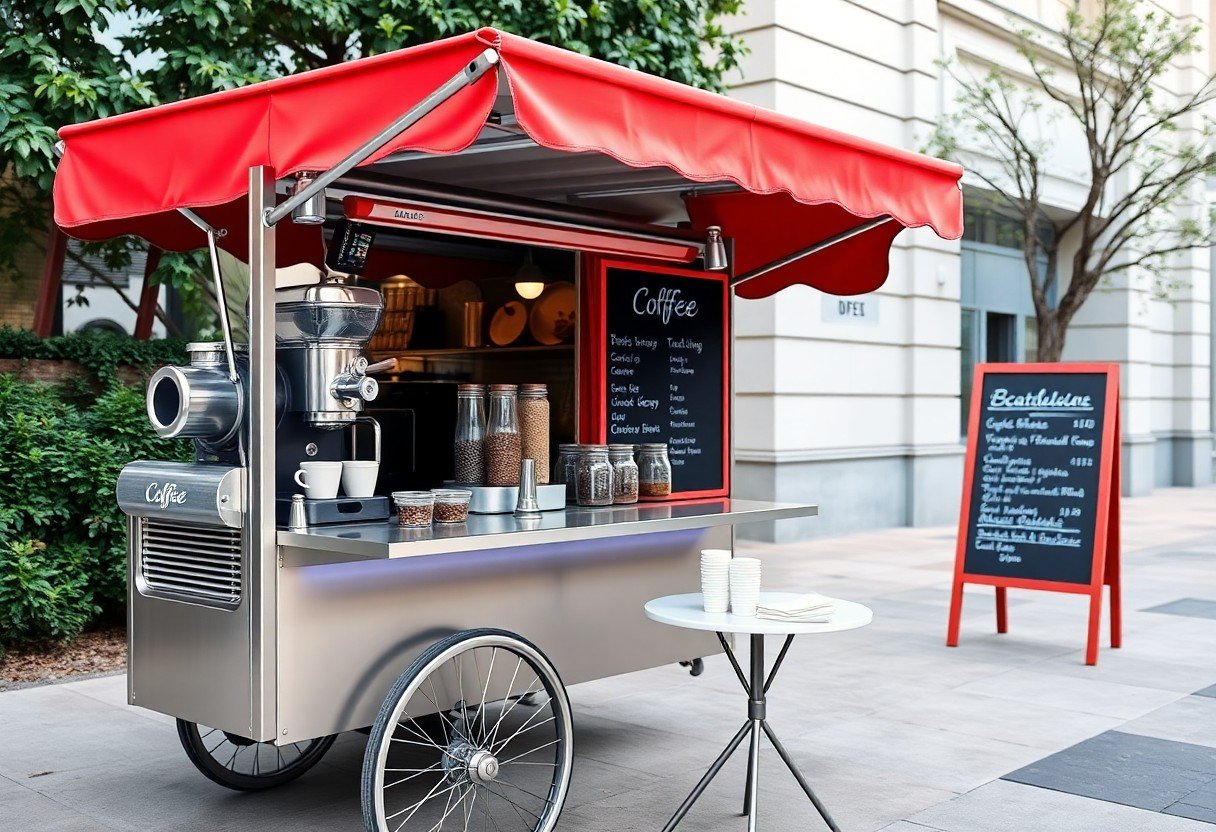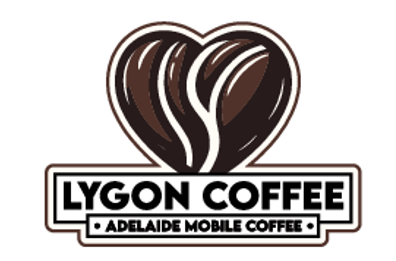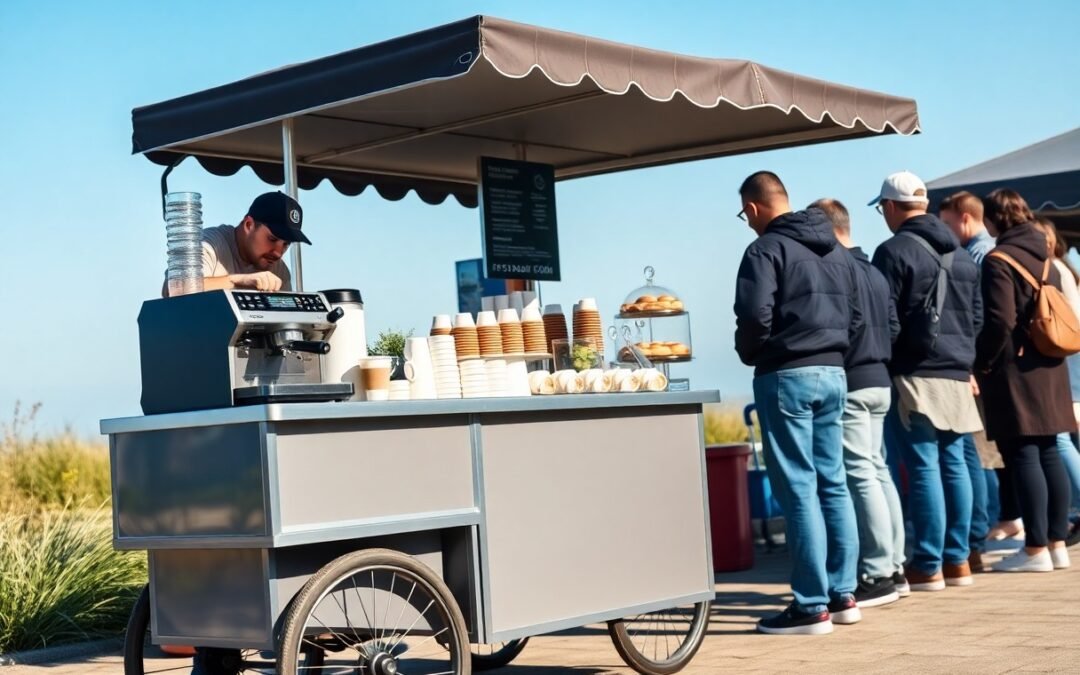You can turn your passion for coffee into a thriving mobile business with the right approach and planning. This guide will provide you with necessary steps to set up, manage, and successfully operate a simple mobile coffee stand. From selecting the right equipment to choosing prime locations, you’ll learn how to attract customers and make a profit while delivering quality brews on the go.

Crafting Your Coffee Stand Vision
Creating a clear vision for your coffee stand shapes every aspect of your business, from branding to customer engagement. Articulate the essence of your venture, whether it’s promoting sustainable sourcing, emphasizing artisanal brewing techniques, or fostering community connections. This vision serves as a guiding star, ensuring every decision aligns with your core values and unique identity, helping you stand out in a crowded market.
Defining Your Unique Selling Proposition
Your unique selling proposition (USP) distinguishes your coffee stand from competitors. Consider specific offerings like specialty brews, organic ingredients, or unique flavor combinations. Focus on a single element that taps into customer desires, such as direct trade relationships or locally sourced food pairings. This distinctiveness not only attracts customers but also fosters loyalty, as they connect with what makes your stand special.
Imagining Your Ideal Customer Experience
Envisioning your ideal customer experience involves crafting every touchpoint, from initial interaction to post-purchase connection. Think about how your stand’s layout, product selection, and service style create an inviting atmosphere that encourages repeat visits. Elements such as vibrant branding, unique menu offerings, and friendly staff interactions can transform casual customers into raving fans who appreciate the thoughtfulness behind their coffee experience.
Delve deeper into the customer journey by investing time in understanding their preferences and feedback. For instance, implementing a loyalty program can add value while enhancing satisfaction. Engaging customers through social media or community events further cultivates a sense of belonging, inviting them to share their experiences with friends. Every detail matters, whether it’s the aroma of freshly brewed coffee wafting through the air or the inviting decor that creates a warm, welcoming vibe.
Navigating Legalities and Permits
Understanding legalities and permits is important for running a mobile coffee stand. Each location will have specific regulations regarding food and beverage sales, health and safety codes, and zoning laws. Familiarize yourself with local ordinances by contacting city hall or your local health department. Compliance not only avoids fines but also builds trust with customers.
Necessary Licenses and Regulations Explained
Obtaining the proper licenses is a foundational step for your mobile coffee stand. Common requirements include a food handler’s permit, a business license, and possibly a seller’s permit, depending on your state. Health inspections may also be required to ensure that your stand meets sanitation standards. Check with local authorities to ensure compliance with all necessary regulations.
Securing Your Commitments: Contracts and Agreements
Establishing clear agreements is vital for successful operations. Whether you’re partnering with vendors or securing event locations, contracts outline expectations and protect your interests. Written agreements should detail responsibilities, payment terms, and cancellation policies, providing clarity and security for both parties involved.
Thoroughly crafting your contracts involves defining scope and deliverables precisely. For instance, if partnering with a local event organizer, specify the number of days you’ll operate, the agreed prices, and any responsibilities regarding setup and breakdown. Including a clause for contingency plans can also save you from unexpected issues, ensuring a smoother operation. Additionally, seek legal advice to ensure your contracts comply with local laws and effectively mitigate risks.
Sourcing Quality Ingredients and Equipment
Building a successful mobile coffee stand hinges on sourcing the best ingredients and equipment. Quality coffee beans, fresh dairy products, and flavorful syrups can significantly impact your offerings, attracting repeat customers and enhancing your reputation. Look for reliable suppliers who prioritize freshness and sustainability, as this resonates with modern consumers. Consider the logistical aspects, such as storage and transport, to maintain the integrity of your products while keeping costs manageable.
Partnering with Local Suppliers for Freshness
Collaborating with local suppliers ensures you receive the freshest ingredients, which can elevate your coffee offerings. By sourcing beans from nearby roasters, you can secure the best blends while supporting your community. Local dairy farms or artisanal bakeries can enhance your menu with unique milk options or pastries. This not only reduces transportation costs but also provides a compelling story that you can share with customers, fostering a sense of connection.
Choosing the Right Brewing Equipment
Selecting the appropriate brewing equipment is fundamental to producing high-quality coffee. Invest in reliable machines that suit your scale and style, such as espresso machines with programmable settings for consistency. Consider portable options for ease of transportation and setup. Popular choices include pour-over rigs, French presses, or advanced espresso machines, each offering distinct flavor profiles. Additionally, budget for grinders that ensure your beans are freshly ground, as this greatly affects taste and aroma.
Explore various brewing methods to cater to diverse customer preferences while optimizing equipment for efficiency. Popular espresso machines like the Breville Barista Pro balance quality and user-friendliness, making them ideal for mobile setups. Pour-over systems, such as the Hario V60, allow for elegant brewing, creating a unique experience that can attract aficionados. Evaluate your workflow and consider multitasking capabilities; investing in a grinder with a built-in scale streamlines operations, crucial during busy hours. Ultimately, choose equipment that best aligns with your brand’s image and target audience to ensure satisfaction.
Designing Your Stand for Maximum Impact
Creating a visually appealing stand sets you apart in a competitive market. Focus on a cohesive color scheme that reflects your brand, ensuring your coffee stand is memorable and inviting. Use materials that enhance your stand’s aesthetic while being durable and easy to clean. Position your stand in high-traffic areas and create an inviting atmosphere that encourages customers to approach and engage with the space. Ultimately, your design should not only attract customers but also facilitate a seamless service experience.
Creating Inviting Visuals and Signage
Eye-catching visuals and clear signage are crucial for drawing in customers. Use bold, legible fonts and bright colors that represent your brand. Imagery of your offerings can create immediate interest. For example, a large, high-quality picture of your signature coffee can entice passersby. Ensure that your menu is easy to read from a distance, including prices and specialty items. Incorporating seasonal promotions in your signage can further attract attention and enhance customer engagement.
Optimizing Your Layout for Efficiency
An efficient layout maximizes service speed and enhances customer experience. Position items based on frequency of use: place your espresso machine and grinder close together, while keeping supplies like cups, lids, and straws within easy reach. Organizing your stand in zones helps streamline workflow; for instance, designate a specific area for order taking to avoid congestion. An open layout encourages customers to approach from multiple directions, helping to reduce wait times and improve service flow.
Consider the flow of customer traffic and service processes when designing your layout. Implement a clear path from ordering to pickup, ensuring that customers and staff can move easily without obstruction. For instance, using a setup where customers can order on one side and collect their drinks on the opposite can minimize bottlenecks. Regularly evaluate your layout based on customer feedback and sales data to identify opportunities for further refinement, ensuring your stand operates at peak efficiency during busy hours.
Implementing Marketing Strategies
Effective marketing strategies are imperative to attract customers and create a loyal following for your mobile coffee stand. Utilize various channels to promote your offerings, including social media, local events, and community engagement initiatives. Tailoring your approach to resonate with your target audience will enhance visibility and promote growth. Maintaining a consistent brand message and showcasing what makes your stand unique will give you a competitive edge.
Leveraging Social Media to Build Anticipation
Social media platforms are powerful tools for generating excitement around your mobile coffee stand. Regularly post content featuring your menu, behind-the-scenes preparation, and customer testimonials to engage your audience. Utilize story features to showcase daily locations or special promotions, increasing anticipation. Using local hashtags can also help reach a broader audience, ensuring that coffee enthusiasts in your area are informed about your stand.
Engaging with the Community and Local Events
Active engagement in community events boosts your visibility and fosters relationships with local customers. Set up your stand at farmers’ markets, community fairs, or festivals to showcase your offerings while supporting local initiatives. Participating not only draws in new customers but also establishes your brand as a vital part of the local culture. Offering free samples or special event discounts can further enhance customer engagement and loyalty.
Participating in local events presents an excellent opportunity to network and build rapport within the community. By collaborating with nearby businesses, you can cross-promote services, creating a mutually beneficial relationship. For example, partnering with local bakeries to offer combined discounts can attract customers to both stands. Organizing workshops or coffee tastings at these events not only showcases your expertise but also invites interaction, allowing potential customers to experience your coffee firsthand. Building relationships through community involvement fosters trust and familiarity, helping to secure repeat business over time.
Conclusion
From above, you have learned the imperative steps to successfully run a simple mobile coffee stand. By selecting the right location, sourcing quality ingredients, and creating an effective marketing strategy, you can attract a loyal customer base. Focus on delivering exceptional service and maintaining cleanliness, which will enhance your reputation. With dedication and passion, you can turn your mobile coffee stand into a thriving business that serves delicious beverages to coffee lovers everywhere.
FAQ
Q: What permits do I need to start a mobile coffee stand?
A: You typically need a business license, health department permits, and a food service permit. Check local regulations for specific requirements in your area.
Q: What equipment is necessary for a mobile coffee stand?
A: Essential equipment includes an espresso machine, grinder, coffee brewing equipment, a generator, water supply, storage containers, and serving materials.
Q: How do I source quality coffee beans?
A: Research local roasters or suppliers that offer ethically sourced beans. Consider sampling different roasts to find the flavors that suit your target market.
Q: What should I consider for menu planning?
A: Focus on a limited selection of popular beverages, seasonal offerings, and food pairings. Include options for different dietary preferences, like dairy-free or vegan items.
Q: How can I effectively market my mobile coffee stand?
A: Utilize social media to showcase your offerings, engage with customers, and share your location. Attend local events and collaborate with other vendors for increased visibility.

